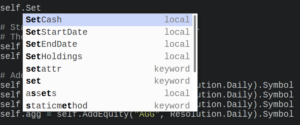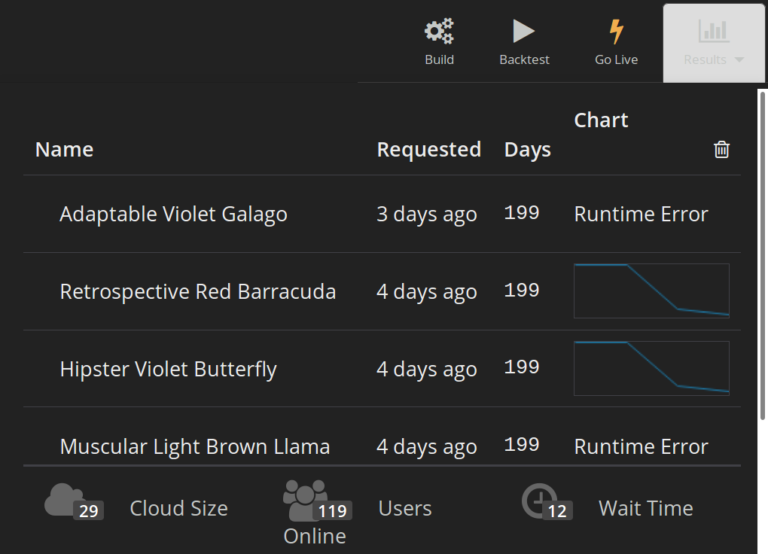Anyone with a strong interest in finance will eventually hear of “quants” — the mystical math prodigies behind many of the trades on Wall Street today. While Quantitative Analysts come in a few varieties, I find algorithmic traders the most exciting. They’re responsible for crafting sophisticated computer programs to automatically trade equities, currencies, futures, and really anything and everything else that can turn a profit. Traditionally, having the resources to trade live — with real money — has been restricted to multi-million (or billion) dollar hedge funds. QuantConnect is a platform that allows anyone to create live trading algorithms.
This means you can connect your Interactive Brokers/E-Trade/Gdax/whatever account to QuantConnect and build a simple program to trade on your behalf. Hell, you might create the next cutting-edge innovation, license it to a company for millions, and retire in the Caribbean.
So, without further ado: a hands on review on QuantConnect.
Interface

The online IDE is intuitive. Upon starting an algorithm, three programming options are available: C#, Python, and F#. Initially, I felt the abundance of language options to be frivolous, but now I can’t imagine any other way. Find a great library in C# you’d like to add? Want to code some ML with SKLearn in Python? No problem. What really stands out is the ability to add multiple files. This is an enormous help when developing complex algorithms or importing third party libraries. It replicates a more natural coding environment without the usual limitations of an online interface.

Must-haves such as syntax highlighting and auto complete work brilliantly. Most of the time the prompt is automatic. Just like other IDEs, it can be manually invoked with Ctrl + Space.

Still not a fan of developing in a web browser? Since the framework that runs QC is open source, it’s a breeze to get it running locally so you can use visual studio (or vim) — which is a good thing, because you’ll probably need it. As capable as the system is, it falls short on debugging. There is no interactive debugger, so you’ll be stuck relying on error messages that look like this:
scheduled event EveryDay: SPY: 10 min after MarketOpen. The error was
Python.Runtime.PythonException: NameError : global name 'foobar' is not
defined
Notice something missing? There’s no line number! Leaving you stuck guessing exactly where the flaw lies. I should mention, this is only a problem with runtime errors. Any problems during compilation will be flagged and the line number identified.

Collaborating with a friend? QC makes this a breeze. Simply hit share and you can work in tandem. Want to rename, move, or delete a project? All actions are as expected.
Overall, the interface does it’s job very well.
Speed
There’s two important aspects to “speed” during algorithm development. The time a backtest takes to complete, and the delay before receiving live data.
Backtesting speed is comparable to any other platform. You might expect to see large differences between an algorithm programmed in C# and an algorithm in Python. Empirical evidence suggests this is not the case. Runtimes were nearly identical across languages.
| Language | Average Time |
|---|---|
| C# | 6.183333333 |
| Python | 6.76666666 |
Occasionally, there has been a wait time before starting a backtest; indicated in the results chart. This can be very annoying when trying to meet a deadline — but in my experience it’s a rare enough occurrence to not be a concern.

QuantConnect advertises co-located servers with minimal delay. A post from the founder on Reddit suggests speeds between 20 and 100ms. This may not be directly competitive with Wall Street firms, but it far exceeds any competition available for personal accounts. The delay is enough to be prohibitive for very high frequency trades, but is still impressive. Note that we took QuantConnect on their word here. These times were not tested.
Community
Small but mighty! In my experience, searching alone will seldom solve your problem — but people are happy to help. Posting a specific question on the forum typically yields a quick response. The QuantConnect team is also very active and helpful. They go as far as to offer free code reviews to interested users.
Price
If you’re only looking for a research platform, the price can be free. However, if you have absolutely no interest in live trading, there are plenty of alternatives. To take advantage of where QC really excels, the price starts at $20/month. Depending on the size of your portfolio, that may sound too good to be true, or a little steep. However, I’m confident even rather small portfolios will more than make up for the price with a good algorithm.
The real expense happens if you want to run multiple algorithms simultaneously. Each algorithm runs on its own, isolated VPS. This creates large reliability and performance benefits, but comes at a cost. Every additional algorithm is an added $10.
Bonus features
One unique feature QC has to offer is version control. Every time an algorithm is backtested, a snapshot is created. This allows for development without worry — knowing you can revert to a previous version at any time.
Alternatives
Quantopian, once a fierce competitor, has suspended all live trading. It is still a capable research platform, if you’re willing to forgo trading with real money.
IBridgePy is a self-hosted solution compatible with Interactive Brokers.
Most other alternatives are inaccessible to the average investor and targeted towards hedge funds. AlgoTrader is a prime example.
Bottom Line
QuantConnect is not without its problems — no platform is. However, it far exceeds anything offered by the competition and is improving everyday. At a competitive price with a tremendous staff, no one else comes close.
Oh, and if you do end up retired under 30, sipping Piña Colladas by the beach — don’t forget about the blogger that helped get you there. 🙂
Thanks to the wonderful guide
Hello there! Do you use Twitter? I’d like to follow you if that would be ok. I’m absolutely enjoying your blog and look forward to new updates.
Hi Charita, thanks for the kind words. Absolutely, follow @_TECHNOHEDGE_. I’m focusing on content right now, but I’ll try to be more active on social media moving forward.